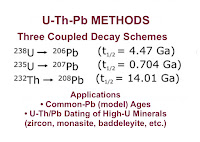God has told us that when He made the earth it was not as a magma ocean that first had to crystallize and cool so that liquid water could condense on it. According to the opening verses of the first chapter of Genesis, the earth God made was already covered in water. God the eyewitness trumps the scientists who were not there to see what happened “in the beginning.”
Continuing with the assumptions:
3. Clock never disturbed. The third of the assumptions is that the time clock was never disturbed over the 4.55 billion years of claimed existence.
Jack Hills is part of a range of hills in
mid-Western Australia where it is claimed the oldest source of material of
terrestrial origin found on Earth
That is, of the hundreds of zircons that were analyzed and dated, only four yielded dates greater than 4.3 billion years old. Yet as the writers admit, those four grains have been used to provide this basis. In other words, from four microscopic mineral grains out of hundreds a whole story has been told about the early history of the earth. That story is based on the assumption that only random natural processes have operated over eons of time with no hint that any Creator was necessary or involved.
The half-life of 238U is comparable to the age of Earth and roughly ½ has decayed since solar system formation. The
half-life of 235U is much shorter that the age of Earth, so most has since
decayed away. Because the decay rates of 238U and 235U are very different and
both systems share the same parent and daughter elements, these radioactive
decay schemes may be applied in combination to model open-system behavior since
closure of the parent-daughter system
As Andrew A. Snelling and Elizabeth Mitchell report: Like other scientists who have previously dated this and the other zircon grains, the authors of this study never question that the U-Th-Pb dating method is anything but reliable in providing absolute ages. While recognizing potential problems owing to the mobility of lead atoms within the zircon grain, they are completely blind to the many other unverifiable, worldview-based assumptions that govern their interpretation of their entire radiometric dating methodology.
They never recognize the underlying unprovable assumptions on which the U-Th-Pb system is based. The starting conditions (i.e., the amount of lead present when the crystal formed) can never be known—how do we know that none of the daughter lead atoms we measure today were not there in the zircon grain at the beginning? Actually, they do assume there were at least some daughter lead atoms at the beginning, but only because of what is believed to be primordial lead in one iron meteorite, which has no parent uranium atoms but some daughter lead atoms in it!
They are therefore constrained by what they believe about that meteorite to concede that some lead atoms could have been present when this zircon grain originally formed, even though lead atoms are thought to not fit into the zircon crystal lattice. But how much “daughter” lead was not derived by uranium decay? Even admitting that some “daughter” lead atoms might have been in the grain to start with does not tell them how much lead not derived from uranium decay there might have been.
The dates obtained from the three
decay systems should be concordant (given the same age) and represent the age
of the sample, provided these conditions are met
In fact, this is not idle speculation and conjecture! There is solid evidence that radioactive decay rates cannot have been constant. For example, discordant dates have been obtained on the same rocks by the different radioisotope methods.
As an example, the assumption of constant radioisotope decay rates has undergirded the interpretation of all radioisotope data and the establishment of the absolute dates in the uniformitarian geologic timescale. Anomalous (deviating) radioisotope dates that do not fit the chosen timescale are usually explained by open-system behavior and/or inheritance, and then discarded. Because most anomalous radioisotope dates are not published, it is difficult to know just what proportion of dating analyses in geochronology laboratories are discarded.
And in the case of the above tests, discordant dates have been derived from helium diffusion and U-Pb dates on the same zircon crystals.
Actually, coexistent U and Po radiohalos argue against perpetual uniformity of decay rates. So do grossly discordant radiocarbon and radioisotope dates. Given ample evidence observable in the present that decay rates have not been constant throughout the supposed “deep time,” it is not reasonable to assume they have been uniform through unobservable eons.
Argonne National Laboratory's Low-Energy Accelerator Facility which provides
high-yield production of radioisotopes used for medical, national security,
basic science, and industrial applications
That such discordances are often the case has already been discussed, and has been thoroughly tested and documented on some specific strata (Radioisotopes and the age of the earth: Results of a young-earth creationist research initiative, El Cajon, California, pp. 325–392; see also S.A. Austin and A. A. Snelling, 1998. Discordant potassium-argon model and isochron “ages” for Cardenas Basalt (Middle Proterozoic) and associated diabase of eastern Grand Canyon, Arizona).
Furthermore, it is highly significant that there are no obvious geologic or geochemical explanations evident for these discordances. Thus, if it weren’t for the assumption that the approved radioisotope dates are acceptable because they correlate with the conventional uniformitarian timescale, then all the discordant isochron ages could actually be anomalous—that is, deviate from the standard normal or expected results.
(See the next post, “Is There Really Evidence for a Young Earth?-PtIII,”for a list of obvious problems the Geologic Column faces)









No comments:
Post a Comment